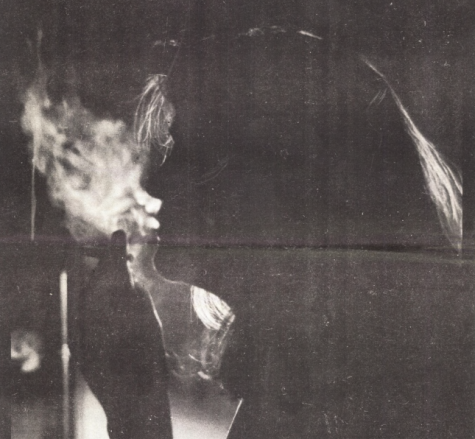Looking back: Let students smoke
This Throwback Thursday, Caroline Mascardo ’22 examines the influence of teachers’ actions on students and tobacco usage at West.
Let students smoke
Originally published in the April 22, 1988 edition of West Side Story by Michelle Piccininni
As the trend in America has shifted putting health and fitness as a priority, so has West High.
One of the major issues of controversy today is a practice that was once acceptable in society: cigarette smoking. Last May, the school board issued a policy that prohibits smoking within school buildings. It is not surprising and, in fact, is expected. Many buildings in Iowa City have had the same policy of being “smoke-free” for some time now. It is reasonable since non-smokers are involuntarily put in danger by the second-hand smoke. Why should they have to leave a room in order to escape the suffocation caused by others?

So was last year’s school board truly concerned about the health of the community? Maybe, but it was probably not the reason for passing this necessary policy. One of the main reasons was because some of the elementary schools did not have a smoking lounge and they felt that it was unfair that some of the schools did.
Making all buildings smoke-free was an easy way to relieve the burden of complaints. The health trend helped the decision along, as did the justification that they didn’t want teachers to tell students that smoking is unhealthy and then go into the lounge and light up during their breaks.
Two of these problems, fairness to other teachers in the district and the danger of second-hand smoke, were eliminated but one still forms a dark cloud over the policy; it prohibits smoking within the building but it says nothing about smoking outside of the building on school grounds. Since students who are caught smoking or carrying tobacco on school grounds are punished, and teachers are not, a double-standard exists.
Is it fair for some to be punished only because of their age? No, it isn’t. Some argue that it is hypocritical to tell students that smoking is deadly and then allow them to smoke on campus, but it is a weak point. The main purpose of public schooling is education. The decision to smoke is up to the individual and punishment will not stop them. The students are constantly told that attendance is important but are forced to miss class because they are suspended for smoking, which does not impair their ability to learn, as do drugs.
If teachers are allowed to smoke outside of the building on school grounds, then students should be able to also. If the district placed ashtrays in the student plaza and declared it a designated smoking area for both students and teachers, many problems would be eliminated. Non-smokers would still have fresh air since it is outside, the pollution of cigarette butts behind the building would stop, students would not miss class because of suspensions for smoking, and the hypocrisy would no longer exist.
Smoking restriction: a subject of debate
Originally published in April 22, 1988 edition of West Side Story by Michelle Piccininni
Earlier this month, a group of students displayed their rage about the smoking rules in school by staking picket signs into the small dirt area in the commons. This year students are not the only ones in the Iowa City Community School District to have restrictions on their smoking habits.

Last May, the school board issued a policy that make all of the schools in the district smoke-free, that is, they prohibited smoking within all of the school buildings. One of the reasons for adopting the policy was in fairness to all of the teachers in the district. Since some of the elementary schools do not have smoking lounges, the teachers were forced to go outside to smoke. They felt that it would only be fair if everyone had a lounge or no one had one. The double standard of telling students they cannot smoke while the teachers and administrators were allowed to may have also contributed to the decision.
Another reason may be due to America’s trend this decade towards health and fitness. Many buildings across the country are smoke-free, including those in Iowa City. Renato de Leon, Dean of Students, felt that health and wellness has been an issue in this country.
“It’s been sort of a theme for society,” he said, and added that it would naturally affect the Iowa City community and its schools.
West High is getting involved with the wellness attitude with the teachers also. An organization called Wellness-A Class Act holds meetings on subjects such as cancer awareness and teachers who attend can earn “incentive points.” At the end of the year, prizes are given away to the highest point earners.
Not everyone agrees with the current smoking rules and restrictions. Dave Dinsmore ’88, said, “Supposedly no one is allowed to smoke on campus but the only people getting busted for it are the few unlucky students who get caught. I have yet to see a teacher get nailed in any way, shape or form, and I’ve seen many more teachers smoking than students. Let’s see them get some in-school!”
What may not be well known is that the smoking policy does not mention that teachers may not smoke outside of the building on the campus. The policy forbids smoking inside of the building on the campus.
de Leon said that “my understanding of it was if they were caught within the building they would be warned” and if the employee repeatedly broke the rule, it could lead to suspension. Dinsmore finds the penalties for students who are caught smoking “overly harsh and very hypocritical” because while students receive suspension, “as far as I know teachers get and occasional warning.” de Leon said that he isn’t “out there to look for kids” so that they will get into trouble.
“While students are on this campus, we don’t want them to be smoking,” he said. “We don’t want to condone smoking.” He said that it would be hypocritical to tell students in health classes and such things that it is unhealthy and then allow them to smoke on campus. But do these rules stop people in the building from smoking?
“There have been days when we caught as many as a half-dozen [students smoking],” said de Leon, but also pointed out that there are also days when no one is caught.
“Just make [the rules] more careful,” said Dinsmore. “Students are out in the parking lot . . . in the bathrooms, out in the baseball dugouts, and the teachers congregate behind the lunch room on the loading dock during lunch.”
Although some believe the policy and rules infringe upon the smokers’ rights, as Dinsmore said “non-smokers have rights too. We need a policy that keeps everyone happy.”
One idea that some students support is to have an outside lounge for both teachers and students, but the possibilities do not seem hopeful.
“I think [a designated smoking lounge] would be a good idea and would work much better than the current policy,” said Dinsmore. “But to be honest, it will never come about. I’d expect the administration to be very stubborn on this issue . . . It’s more realistic to try and get teachers and administrators to practice what they preach.”
de Leon said about an outside lounge, “I think that’s probably been considered but probably will not happen” because of the wellness issue and the possibility of encouraging students to smoke. “I think it would pull in some of the younger students,” he said.
The Iowa City school board is not the only authority making laws against smoking. State law prohibits smoking in retail stores, there is a law that does not allow cigarettes to be sold to those under 18, and even Mayor Koch is leading a battle against smoking in all indoor public areas in New York City. The entire country is asking questions like, “Do these laws take away freedom of choice?” and “Is it fair for non-smokers to be suffocated?” It is a battle that is far from being over.
Why the example teachers set for students is so important
By Caroline Mascardo
As with previous installments of “Looking back,” it’s interesting to see how West has changed over time. While the proposals to allow students to smoke on campus and to add a teacher-student joint smoking lounge threw me for a loop, certain elements of these articles remain pertinent to today. If anything, these articles demonstrate how influential our teachers’ actions are on our own decisions.
While I object to reporter Michelle Piccininni’s demand for students’ ability to smoke on campus, I agree that expectations for teachers and students must be held to a high level. The remarks from Dave Dinsmore ’88 about putting teachers in in-school suspension for smoking at school wasn’t completely inappropriate. After all, teachers shape future generations by imparting valuable information upon them.
And by “valuable information,” I don’t mean just math formulas and the history of 16th-century Europe. While writing this article, I came across a spoken word piece titled “Somewhere in America.” In it, the three authors declare that the most important lessons in school aren’t taught out loud, but instead go unspoken. Therefore, if students are surrounded by teachers that smoke, they may feel more compelled to smoke than if their teachers refrained from doing so. Moreover, if a teacher responds to violence or bullying by denying it, students may become bystanders in similar situations.
The way a teacher treats certain groups of people may also influence a student’s behavior. For instance, if a teacher frequently makes misogynistic remarks towards female students, these students may take said insults to heart. Meanwhile, male students may develop the belief that making sexist jokes is acceptable.
Also, in the first article “Let students smoke,” students cited their teachers’ ability to smoke at West as their main argument for why they should be able to as well. I support the 1988 ICCSD decision to ban smoking on school grounds, not just for health reasons, but also for the sake of the example teachers set for students.
Your donation will support the student journalists of West High School. Your contribution will allow us to purchase Scholarship Yearbooks, newsroom equipment and cover our annual website hosting costs.

(they/them) Caroline Mascardo is a senior at West High, and they are the editorials editor and a copy editor for the print publication. In their free time,...

(she/her) Alex Carlon is a senior at West High and editor-in-chief of the web publication. When she's not helping out on the website she can be found playing...



